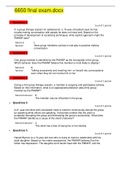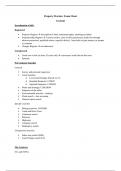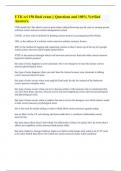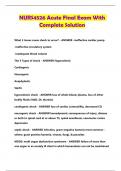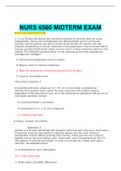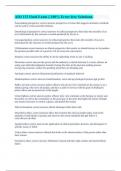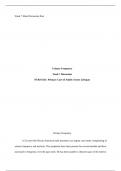Chapter: 4,5,6,7,8,9,16,17,18 Final Exam
, University Preparatory Program
Alfaisal University
PPHYM112 - T172 - Final Exam Dr. Kariapper and Dr. Farid
Multiple Choice
Identify the choice that best completes the statement or answers the question.
____ 1. A cart is sliding down an inclined ramp at a CONSTANT velocity of 0.55 m/s. The net force acting on
this cart is
a. vertically downward.
b. down the ramp.
c. up the ramp.
d. perpendicular to the ramp.
e. zero
Constant velocity → zero acceleration → Net force = 0, from N’s 2nd Law
____ 2. A person of mass 80-kg jumps off the floor with an average initial
acceleration of 2.5 m/s2 (acceleration of the person starting from zero
velocity at the floor to until he looses contact with the floor). What is the
normal force (N) exerted on him from the floor as he jumps off the floor?
a. 584 N.
b. 984 N.
c. 200 N.
d. 784 N.
e. 944 N.
∑ 𝐹𝑦 = 𝑚 𝑎𝑦
𝑁 − 𝑚𝑔 = 𝑚 𝑎
𝑁 = 𝑚 𝑎 + 𝑚𝑔
𝑁 = 80(2.5) + 80(9.8) = 984 m/s2
M. S. Kariapper 1
, atty
University Preparatory Program
Alfaisal University
____ 3. A 50 kg father and his 20 kg daughter are ice-skating. They stand in front of each other face to face. The
daughter pushes on her father such that he accelerates at 2.0 m/s2 during the push. What is the magnitude
of the force the daughter applies on her father?
a. 100 N
b. 40 N
c. 5.0 N
d. 60 N
e. 140 N
Apply 𝐹⃗𝑛𝑒𝑡 = 𝑚𝑎⃗ on father to find the force on father
𝐹⃗𝑛𝑒𝑡 = 𝑚𝑎⃗ = 50(2.0) = 100 𝑁
From Newton’s third law, we conclude that the same magnitude of force but in the opposite
direction is exerted on the daughter from the father.
____ 4. You are traveling on an elevator. Which one of the following forces is the force that is always equal in
magnitude but opposite in direction to your weight?
a. The force of the Earth on the elevator.
b. The force of you on the elevator floor.
c. The force of you on the Earth.
d. The force of the elevator on the Earth
e. The force of elevator floor on you.
Newton’s third law: When the earth exert a force on you (i.e your weight), you exert a force on earth
equal in magnitude but opposite in direction.
____ 5. Calculate the xcm (x coordinate of the center of mass) of this four masses m1= 5.6 g, m2= 8.0 g, m3= 2.2 g
and m4= 3.1 g placed along the x-axis (coordinates in cm) as shown below in the figure.
a. 2.6 cm
b. 4.1 cm
c. 15 cm
d. 3.2 cm
e. 13 cm
1
𝑥𝑐.𝑚. = ∑ 𝑚𝑖 𝑥𝑖
𝑀
1
𝑥𝑐.𝑚. = [5.6(−1) + 8.0(2) + 2.2(6) + 3.1(8)] = 2.56 𝑐𝑚
(5.6 + 8.0 + 2.2 + 3.1)
M. S. Kariapper 2
, University Preparatory Program
Alfaisal University
____ 6. The impulse experienced by a body is equivalent to its change in:
a. the force applied on the body
b. kinetic energy.
c. momentum.
d. velocity.
e. None of the above choices are valid.
Momentum-Impulse theorem
𝐽⃗ = 𝐹⃗ ∆𝑡 = ∆𝑝⃗
____ 7. In an INELASTIC collision between two objects
a. the kinetic energy of the system is conserved, but the momentum of the system is not
conserved.
b. the kinetic energy of each object is conserved.
c. the momentum of the system is conserved but the kinetic energy of the system is not
conserved.
d. both the momentum and the kinetic energy of the system are conserved.
e. the momentum of each object is conserved.
Definition of Inelastic collision
____ 8. A block of mass m = 44 kg has a speed V and is behind a block of mass M = 85 kg that has a speed of 0.5
m/s. The surface is frictionless. The blocks collide and couple. After the collision, the blocks have a
common speed of 0.9 m/s. Initial speed V of the block m is equal to:
a. 2.3 m/s
b. 1.3 m/s
c. 1.7 m/s
d. 1.8 m/s
e. 1.0 m/s
Conservation of linear momentum
∑ 𝑝𝑖,𝑥 = ∑ 𝑝𝑓,𝑥
44 𝑣 + 85 (0.5) = (44 + 85)(0.9)
(44 + 85)(0.9) − 85 (0.5)
𝑣= = 1.67 m/s
44
M. S. Kariapper 3
, University Preparatory Program
Alfaisal University
PPHYM112 - T172 - Final Exam Dr. Kariapper and Dr. Farid
Multiple Choice
Identify the choice that best completes the statement or answers the question.
____ 1. A cart is sliding down an inclined ramp at a CONSTANT velocity of 0.55 m/s. The net force acting on
this cart is
a. vertically downward.
b. down the ramp.
c. up the ramp.
d. perpendicular to the ramp.
e. zero
Constant velocity → zero acceleration → Net force = 0, from N’s 2nd Law
____ 2. A person of mass 80-kg jumps off the floor with an average initial
acceleration of 2.5 m/s2 (acceleration of the person starting from zero
velocity at the floor to until he looses contact with the floor). What is the
normal force (N) exerted on him from the floor as he jumps off the floor?
a. 584 N.
b. 984 N.
c. 200 N.
d. 784 N.
e. 944 N.
∑ 𝐹𝑦 = 𝑚 𝑎𝑦
𝑁 − 𝑚𝑔 = 𝑚 𝑎
𝑁 = 𝑚 𝑎 + 𝑚𝑔
𝑁 = 80(2.5) + 80(9.8) = 984 m/s2
M. S. Kariapper 1
, atty
University Preparatory Program
Alfaisal University
____ 3. A 50 kg father and his 20 kg daughter are ice-skating. They stand in front of each other face to face. The
daughter pushes on her father such that he accelerates at 2.0 m/s2 during the push. What is the magnitude
of the force the daughter applies on her father?
a. 100 N
b. 40 N
c. 5.0 N
d. 60 N
e. 140 N
Apply 𝐹⃗𝑛𝑒𝑡 = 𝑚𝑎⃗ on father to find the force on father
𝐹⃗𝑛𝑒𝑡 = 𝑚𝑎⃗ = 50(2.0) = 100 𝑁
From Newton’s third law, we conclude that the same magnitude of force but in the opposite
direction is exerted on the daughter from the father.
____ 4. You are traveling on an elevator. Which one of the following forces is the force that is always equal in
magnitude but opposite in direction to your weight?
a. The force of the Earth on the elevator.
b. The force of you on the elevator floor.
c. The force of you on the Earth.
d. The force of the elevator on the Earth
e. The force of elevator floor on you.
Newton’s third law: When the earth exert a force on you (i.e your weight), you exert a force on earth
equal in magnitude but opposite in direction.
____ 5. Calculate the xcm (x coordinate of the center of mass) of this four masses m1= 5.6 g, m2= 8.0 g, m3= 2.2 g
and m4= 3.1 g placed along the x-axis (coordinates in cm) as shown below in the figure.
a. 2.6 cm
b. 4.1 cm
c. 15 cm
d. 3.2 cm
e. 13 cm
1
𝑥𝑐.𝑚. = ∑ 𝑚𝑖 𝑥𝑖
𝑀
1
𝑥𝑐.𝑚. = [5.6(−1) + 8.0(2) + 2.2(6) + 3.1(8)] = 2.56 𝑐𝑚
(5.6 + 8.0 + 2.2 + 3.1)
M. S. Kariapper 2
, University Preparatory Program
Alfaisal University
____ 6. The impulse experienced by a body is equivalent to its change in:
a. the force applied on the body
b. kinetic energy.
c. momentum.
d. velocity.
e. None of the above choices are valid.
Momentum-Impulse theorem
𝐽⃗ = 𝐹⃗ ∆𝑡 = ∆𝑝⃗
____ 7. In an INELASTIC collision between two objects
a. the kinetic energy of the system is conserved, but the momentum of the system is not
conserved.
b. the kinetic energy of each object is conserved.
c. the momentum of the system is conserved but the kinetic energy of the system is not
conserved.
d. both the momentum and the kinetic energy of the system are conserved.
e. the momentum of each object is conserved.
Definition of Inelastic collision
____ 8. A block of mass m = 44 kg has a speed V and is behind a block of mass M = 85 kg that has a speed of 0.5
m/s. The surface is frictionless. The blocks collide and couple. After the collision, the blocks have a
common speed of 0.9 m/s. Initial speed V of the block m is equal to:
a. 2.3 m/s
b. 1.3 m/s
c. 1.7 m/s
d. 1.8 m/s
e. 1.0 m/s
Conservation of linear momentum
∑ 𝑝𝑖,𝑥 = ∑ 𝑝𝑓,𝑥
44 𝑣 + 85 (0.5) = (44 + 85)(0.9)
(44 + 85)(0.9) − 85 (0.5)
𝑣= = 1.67 m/s
44
M. S. Kariapper 3

